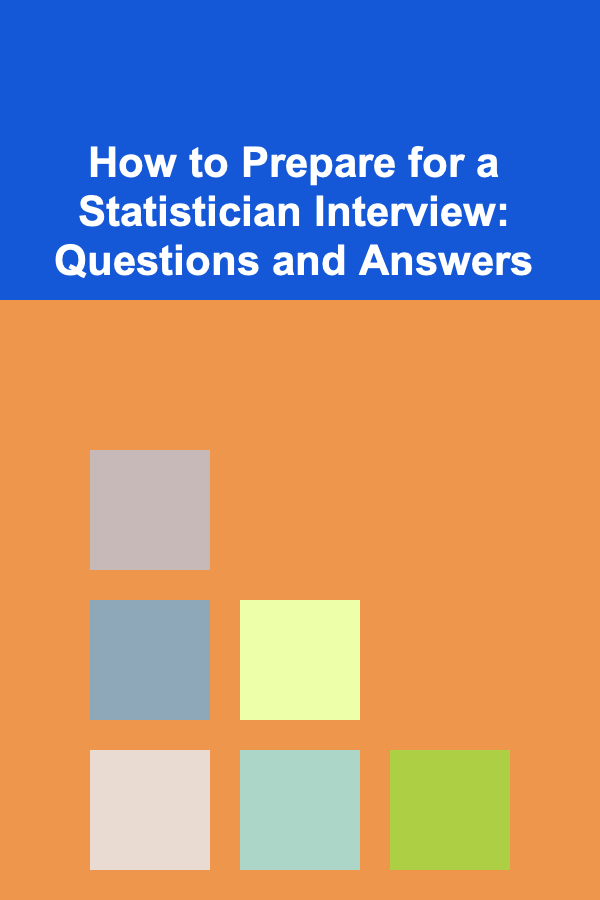
How to Prepare for a Statistician Interview: Questions and Answers
ebook include PDF & Audio bundle (Micro Guide)
$12.99$10.99
Limited Time Offer! Order within the next:

When preparing for a statistician interview, it's essential to understand both the technical skills required and the behavioral aspects that will allow you to shine in front of your interviewers. A statistician's role often includes a blend of mathematical expertise, data analysis, and problem-solving skills. This article will guide you through the necessary steps to prepare effectively, covering the key questions you should expect, the right answers, and tips for performing at your best.
Step 1: Understand the Role of a Statistician
Before diving into the interview questions, it's essential to understand the core duties of a statistician. Statisticians play a critical role in data-driven decision-making across various industries, including healthcare, economics, finance, marketing, and more. The role often involves the collection, analysis, interpretation, and presentation of data to inform strategic decisions. Depending on the industry, a statistician's tasks may also include designing experiments, developing statistical models, and performing hypothesis testing.
Key Responsibilities:
- Data Collection: Gathering data from various sources, ensuring the quality and accuracy of the data.
- Data Analysis: Using statistical techniques to interpret the data, including regression analysis, hypothesis testing, and Bayesian analysis.
- Modeling: Developing predictive models using statistical software tools such as R, SAS, or Python.
- Report Writing: Presenting results in a comprehensible manner through reports, visualizations, and presentations to stakeholders.
- Collaboration: Working with data scientists, business analysts, and other team members to achieve the objectives.
Now that you understand the role, let's explore how to prepare for the interview.
Step 2: Know the Key Skills and Tools
A statistician interview typically assesses both technical knowledge and your ability to communicate complex statistical concepts. Here's a breakdown of the essential skills and tools you'll need to demonstrate proficiency in during the interview.
2.1. Statistical Knowledge
Ensure that you have a strong grasp of the following topics:
- Probability Theory: Understanding random variables, distributions (e.g., normal, binomial, Poisson), expected values, variance, and probability laws.
- Statistical Inference: Hypothesis testing, confidence intervals, p-values, Type I and Type II errors, and significance levels.
- Regression Analysis: Simple linear regression, multiple regression, logistic regression, and model diagnostics.
- Time Series Analysis: Autocorrelation, trend analysis, forecasting methods, and ARIMA models.
- Multivariate Statistics: Principal component analysis (PCA), factor analysis, and cluster analysis.
- Bayesian Statistics: Prior and posterior distributions, Bayesian inference, and Markov Chain Monte Carlo (MCMC) methods.
2.2. Statistical Software
Statisticians rely on a variety of software tools to analyze data. Be prepared to discuss the software you are proficient in, and consider reviewing the following tools:
- R: Widely used for statistical computing and graphics.
- SAS: A software suite for advanced analytics, business intelligence, and predictive analytics.
- Python: Commonly used for data science tasks, especially with libraries like pandas, NumPy, SciPy, and Statsmodels.
- SPSS: Software for statistical analysis in the social sciences.
- Excel: While not as advanced as R or Python, Excel is still a common tool for basic statistical analysis.
2.3. Data Visualization
Being able to visualize data and results effectively is essential. Familiarize yourself with the tools and techniques to create meaningful charts, graphs, and dashboards. Proficiency in tools such as Tableau , Power BI , and libraries like Matplotlib (Python) or ggplot2 (R) will set you apart.
2.4. Problem-Solving Abilities
Statisticians are often tasked with solving real-world problems using data. The interview may include case studies or situational questions that test your problem-solving skills. Demonstrating your ability to identify issues, design experiments, and draw conclusions from data will be crucial.
Step 3: Behavioral Interview Questions
While technical skills are essential, employers also want to know if you are a good fit for their team and company culture. Expect questions that assess your interpersonal skills, work ethic, and attitude.
Common Behavioral Questions:
-
Tell me about a time when you had to explain complex statistical concepts to someone with little or no statistical knowledge.
- Tip: Focus on how you tailored your explanation to the audience, using simple language or analogies to make the concepts clear.
-
Describe a situation in which you had to work with a difficult dataset. How did you approach it?
- Tip: Discuss the challenges you faced (e.g., missing data, outliers, or skewed distributions) and the steps you took to clean, process, and analyze the data.
-
Tell us about a time when you used data to drive decision-making.
- Tip: Share a specific example where your analysis led to actionable insights and how those insights impacted business or operational decisions.
-
How do you prioritize multiple projects with competing deadlines?
- Tip: Demonstrate your organizational and time-management skills. Discuss how you assess project priorities, communicate with stakeholders, and maintain quality work under pressure.
-
Describe a challenging problem you solved using statistical modeling.
- Tip: Discuss the modeling techniques you employed, the results you obtained, and how the model contributed to solving the problem.
Step 4: Technical Interview Questions
The technical portion of the interview will assess your knowledge of statistical techniques and your ability to apply them in real-world scenarios. Below are some typical technical questions and tips on how to approach them.
4.1. Probability and Statistics
-
Question: What is the difference between a population and a sample? How would you handle sampling bias?
- Tip: Clearly define the terms and discuss how sampling bias can be mitigated through random sampling, stratification, or re-sampling techniques.
-
Question: Explain the concept of p-value and its significance in hypothesis testing.
- Tip: Define the p-value, discuss its relationship to the significance level, and describe how it helps in making decisions regarding null hypotheses.
4.2. Regression Analysis
-
Question: How would you assess whether a linear regression model is a good fit for the data?
- Tip: Discuss diagnostic plots (e.g., residuals vs. fitted values), R-squared, adjusted R-squared, p-values for coefficients, and multicollinearity tests (e.g., VIF).
-
Question: Can you explain multicollinearity and how it affects regression models?
- Tip: Define multicollinearity and its potential impact on regression results, and discuss methods like variance inflation factor (VIF) to detect it.
4.3. Statistical Inference
-
Question: How would you handle missing data in a dataset?
- Tip: Mention techniques such as imputation (mean, median, mode imputation), regression imputation, or using algorithms like k-nearest neighbors for missing data handling.
-
Question: What is the difference between Type I and Type II errors in hypothesis testing?
- Tip: Explain the errors and their implications, and discuss how the power of a test relates to the likelihood of Type II errors.
4.4. Data Handling and Cleaning
- Question : What steps do you take when cleaning a dataset for analysis?
- Tip: Discuss common steps such as identifying missing values, removing or imputing outliers, checking for duplicate records, and ensuring data consistency.
4.5. Advanced Topics
-
Question: What is the difference between a parametric and non-parametric test?
- Tip: Explain that parametric tests assume a certain distribution (e.g., normal distribution), while non-parametric tests do not make such assumptions.
-
Question: How would you build a predictive model for a binary classification problem?
- Tip: Discuss the process, starting from data preprocessing, feature selection, model selection (e.g., logistic regression, decision trees), and evaluation metrics like accuracy, precision, recall, and ROC curve.
Step 5: Practical Exercises and Case Studies
Some interview processes involve practical exercises or case studies where you'll be asked to analyze a dataset and present your findings. Here's how to prepare:
- Understand the Problem: Carefully read the case description and identify the key questions you need to answer.
- Analyze the Data: Use appropriate statistical methods to analyze the dataset. Be sure to clean the data if necessary and explore it thoroughly before modeling.
- Communicate Clearly: Present your findings in a clear, concise manner. Use visualizations to help explain complex data patterns, and ensure your conclusions are actionable.
- Show Your Work: If you use statistical software, make sure you can explain how you arrived at each step of the analysis.
Step 6: Ask Insightful Questions
At the end of the interview, you'll likely be asked if you have any questions. This is an opportunity to demonstrate your interest in the role and the company. Here are some insightful questions you might ask:
- What types of data projects will I be working on initially?
- What tools and software does the team currently use for data analysis?
- How does the company incorporate statistical analysis into its decision-making process?
- What are the biggest challenges the team is currently facing in terms of data analysis?
Step 7: Final Tips
- Practice: Review common interview questions and practice your responses, especially technical ones. You can also take mock interviews to build confidence.
- Stay Calm: Technical interviews can be intense, but it's essential to stay calm. Take your time to think through the questions and communicate your thought process.
- Show Enthusiasm: Employers appreciate candidates who are passionate about data analysis and problem-solving. Show enthusiasm for the role and the company.
Conclusion
Preparing for a statistician interview involves a combination of technical expertise, problem-solving abilities, and clear communication skills. By thoroughly understanding the key skills required, practicing technical questions, and being ready to discuss your experiences, you can excel in the interview. With the right preparation, you'll be well on your way to securing the job of your dreams as a statistician.
Reading More From Our Other Websites
- [Organization Tip 101] How to Use Apps to Keep Your Recipes Organized
- [Organization Tip 101] Step-by-Step Guide to Installing Peel and Stick Wallpaper
- [Personal Care Tips 101] How to Adopt a Personal Care Routine for a Healthy Lifestyle
- [Home Rental Property 101] How to Market Your Rental Property on Social Media
- [Home Holiday Decoration 101] Best Ways to Use Natural Elements in Your Holiday Home Decor
- [Home Renovating 101] How to Tackle a Seamless Bathtub Replacement Without Calling a Plumber
- [Personal Care Tips 101] How to Choose Soap with Essential Oils for a Fragrant Experience
- [Home Maintenance 101] How to Keep Your Home's Staircases Safe and Well-Maintained
- [Home Lighting 101] How to Install Dimmable Lighting for More Control
- [Organization Tip 101] How to Encourage Team Collaboration with Organized Spaces

How to Create a Safe Environment for Event Attendees
Read More
How to Host a Budget-Friendly Party at Home
Read More
How to Maintain a Clean Home While Managing a Busy Schedule
Read More
Unlocking Success as a Legal Secretary: A Comprehensive Guide to Legal Office Efficiency
Read More
How to Create Interactive Greeting Cards
Read More
10 Tips for Choosing the Right Yarn for Tapestry Weaving
Read MoreOther Products

How to Create a Safe Environment for Event Attendees
Read More
How to Host a Budget-Friendly Party at Home
Read More
How to Maintain a Clean Home While Managing a Busy Schedule
Read More
Unlocking Success as a Legal Secretary: A Comprehensive Guide to Legal Office Efficiency
Read More
How to Create Interactive Greeting Cards
Read More